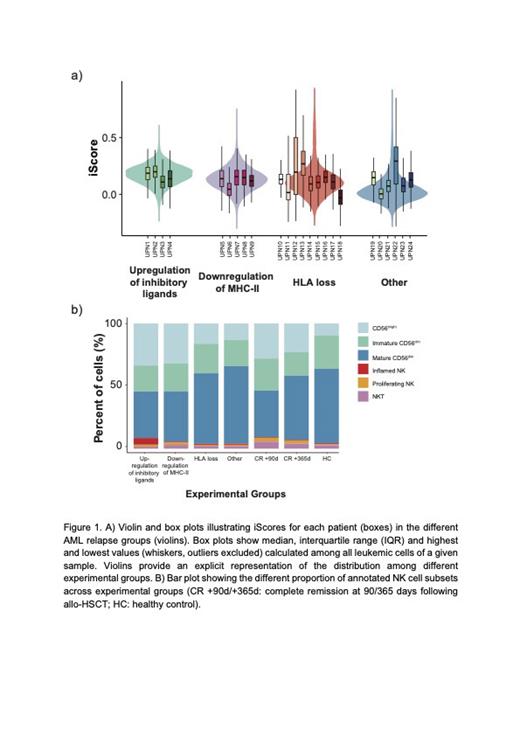Allogeneic Hematopoietic Cell Transplantation (allo-HCT) represents the most successful therapeutic option for many patients suffering from Acute Myeloid Leukemia (AML). Nevertheless, leukemic cells often find means to evade control from the donor-derived immune system and re-emerge. To date, three alternative and frequent mechanisms by which AML cells modify their features and escape immune control have been described: genetic loss of the mismatched HLA haplotype (HLA loss), downregulation of HLA class II molecules and upregulation of inhibitory ligands, all ultimately leading to abolished leukemia recognition by T lymphocytes. However, increasing evidence suggests that leukemic cells weave a much broader net of interactions, involving several other immune cell types within the bone marrow microenvironment. Still, how this complex crosstalk between malignant cells and the bone marrow niche may shape the features of leukemia post-transplant relapse remains unknown.
By exploiting the high resolution provided by single-cell RNA-sequencing (scRNA-seq), we provide a detailed insight of the human bone marrow immune microenvironment and the changes that occur following allo-HCT, both when disease reemergence is prevented, and when it occurs.
Using cryopreserved BM aspirates, we profiled a total of 145,420 mononuclear cells from 25 adult AML patients at the time of disease relapse; 56,831 cells from 5 post-transplant patients in complete remission (CR), each tested at two different timepoints (+90 and +365 days) and 45,279 cells from 6 healthy controls (HC). First, scRNA-seq allowed us to recapitulate known leukemia-intrinsic features of each relapse modality, such as HLA loss, down-regulation of HLA class II molecules and upregulation of inhibitory T cell ligands. Moreover, combining genotype and Copy Number Variation (CNV) inference algorithms, we were able to separate malignant cells from their healthy counterparts. Interestingly, HLA loss relapses exhibited a more immature profile, with a significantly higher leukemia stem cell signature (LSC17) (p-value < 0.0001, Wilcoxon rank-sum test) (Ng SW et al., Nature 2016), hinting that the hematopoietic cell of origin impacts on the mechanism of post-transplantation relapse. Leukemic cells also featured a high inflammation-associated gene score (iScore) (Lasry A et al., Nat Cancer 2023), as also evident in non-malignant HSPCs from relapsed patients, which showed an increased IFN-α signature compared to HC and CR. However, AML samples that couldn't be categorized by a known mechanism of relapse displayed a significantly lower iScore, suggesting that leukemia escape in these patients might not have had an immune-related driver (Figure 1a).
We next sought to characterize specific BM immune compartments. We overall detected a lower frequency of CD4 T cells in relapsed patients as compared to HC and CR patients (p-value = 0.04, Wilcoxon rank-sum test). We annotated 5 major Natural Killer (NK) cell clusters (immature CD56 dim, mature CD56 dim, CD56 bright, proliferating NK, NKT cells) and a smaller subset of immature CD56 bright NK cells characterized by higher expression of IFN-related genes and NK exhaustion markers, which was defined as inflamed NK cluster. Inflamed NK cells were more represented in patients with upregulation of T cell inhibitory ligands compared to other relapsed patients (5.42% of total NK vs. 0.74%, respectively. p-value = 0.03, Wilcoxon rank-sum test), thus suggesting a shared mechanism of dysfunction signature between T and NK cell that may favor leukemia immune evasion (Figure 1b).
In conclusion, we generated a comprehensive atlas of the BM immune microenvironment in AML post-transplantation relapses, showing that inflammation shapes immune subset composition and transcriptional profile in the BM, and that leukemia mechanisms of immune evasion are influenced by the surrounding milieu. Overall, while an in depth understanding of whether leukemia relapse is caused by an inflamed microenvironment, or vice versa, might only be achieved through longitudinal sampling from patients before and after transplant, our results here exemplify how the BM niche could be exploited to find novel vulnerabilities in AML relapses, to be specifically targeted by personalized therapeutic approaches.
Disclosures
Gentner:GENENTA SCIENCE: Consultancy, Current equity holder in publicly-traded company, Research Funding.


This feature is available to Subscribers Only
Sign In or Create an Account Close Modal